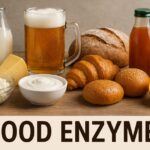
Shrijiexbiz Pvt Ltd is at the forefront of sustainable innovation in the textile industry through its advanced enzyme solutions. Our textile-grade enzymes are designed to replace harsh chemicals traditionally used in processes such as desizing, scouring, and bio-polishing. These nature-based enzymes offer exceptional performance while being gentle on fabrics and the environment. By using Shrijiexbiz enzymes, textile manufacturers can achieve improved fabric quality, enhanced softness, and vibrant color retention—all while significantly reducing water, energy, and chemical usage. At Shrijiexbiz, we are committed to empowering the textile industry with eco-friendly technologies that drive both efficiency and sustainability.
How Different Enzymes work In Textile Processing ?
1. Amylase – Desizing Enzyme
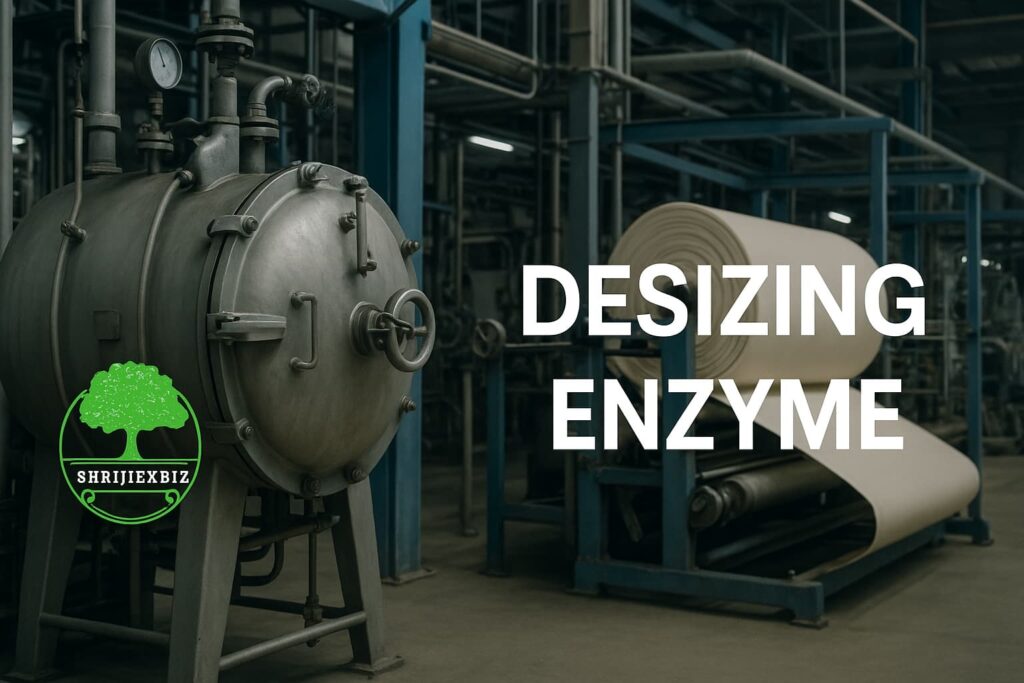
DESCRIPTION
Desizing is a critical first step in textile wet processing, aimed at removing the size materials applied to yarns during weaving. Shrijiexbiz Pvt Ltd offers a high-performance Amylase-based desizing enzyme that efficiently breaks down starch and its derivatives without damaging the fabric. Our enzyme ensures uniform and complete removal of sizing agents, improving the fabric’s absorbency and preparing it for subsequent processes like scouring, bleaching, and dyeing. Designed to work under mild conditions, Shrijiexbiz desizing enzymes reduce water and energy consumption, making them a sustainable and cost-effective solution for modern textile mills.
Use of Amylase in Desizing Process:
Function: Hydrolyzes starch molecules into soluble sugars (dextrins and maltose), making them easy to wash off from the fabric.
Application: Primarily used on cotton and other cellulose-based fabrics that have been sized with starch or starch derivatives.
Benefits:
- Selective Action: Targets only starch without damaging cellulose fibers.
- Improved Fabric Quality: Prevents fabric weakening and ensures uniform dyeing.
- Eco-Friendly: Reduces the need for harsh chemicals like acids or oxidizing agents.
- Lower Water & Energy Use: Operates at moderate conditions, saving water and energy.
- Reduced Effluent Load: Minimizes pollution compared to chemical desizing methods.
- High Efficiency: Quick and effective starch removal even at low enzyme dosages.
2. Cellulase/Lipase/Protease/Pectinase – Scouring Enzymes
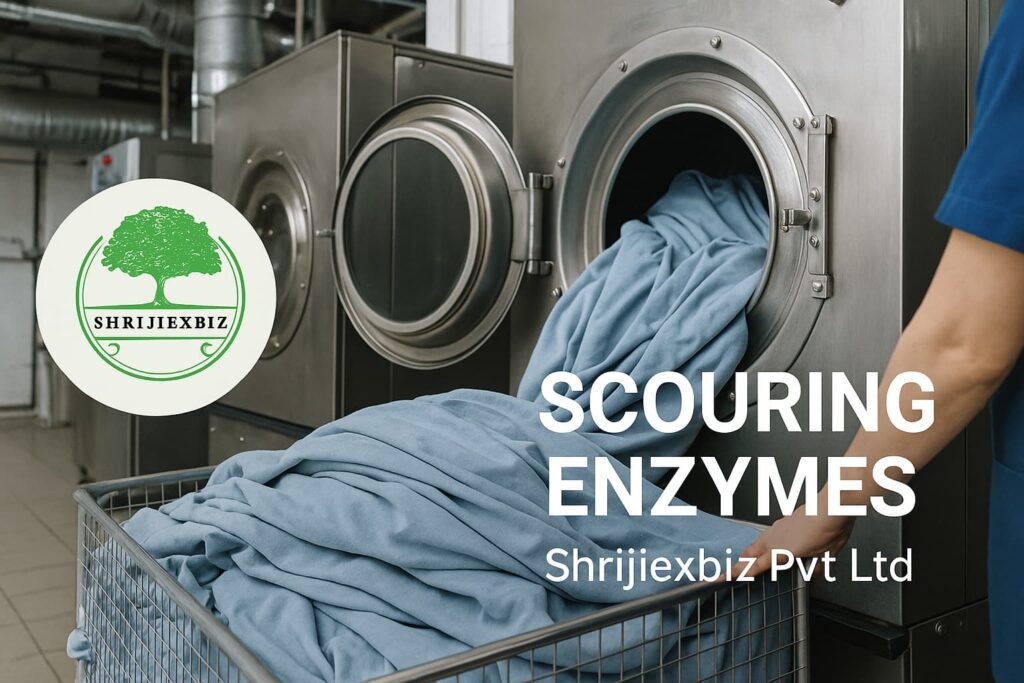
DESCRIPTION
Scouring is a vital process in textile manufacturing that removes natural impurities like waxes, pectins, and oils from cotton and other fibers. Shrijiexbiz Pvt Ltd offers an eco-efficient bioscouring enzyme formulation composed of pectinase, lipase, and cellulase blends designed to effectively replace harsh alkaline chemicals. These enzymes gently yet thoroughly clean the fabric, enhancing its absorbency and preparing it for dyeing and finishing without causing fiber damage. With our scouring enzymes, textile processors can significantly reduce water, energy, and effluent load—making Shrijiexbiz a reliable partner for sustainable textile solutions.
Uses in Textile Industry:
- Pre-treatment of cotton and other natural fibers: Removes non-cellulosic impurities before dyeing and printing.
- Improves absorbency: Essential for effective dye uptake.
- Enhances softness: Gives fabric a smoother and softer feel.
- Eco-friendly alternative: Reduces water, energy, and chemical consumption.
- Reduces fiber damage: Gentler than chemical scouring, preserving fabric strength
Benefits:
- Lower effluent load and pollution.
- Reduced energy and water usage.
- Improved fabric quality and hand feel.
- Cost savings in the long run due to lower process temperatures and reduced reprocessing.
3. Cellulase– Bio-Polishing Enzymes
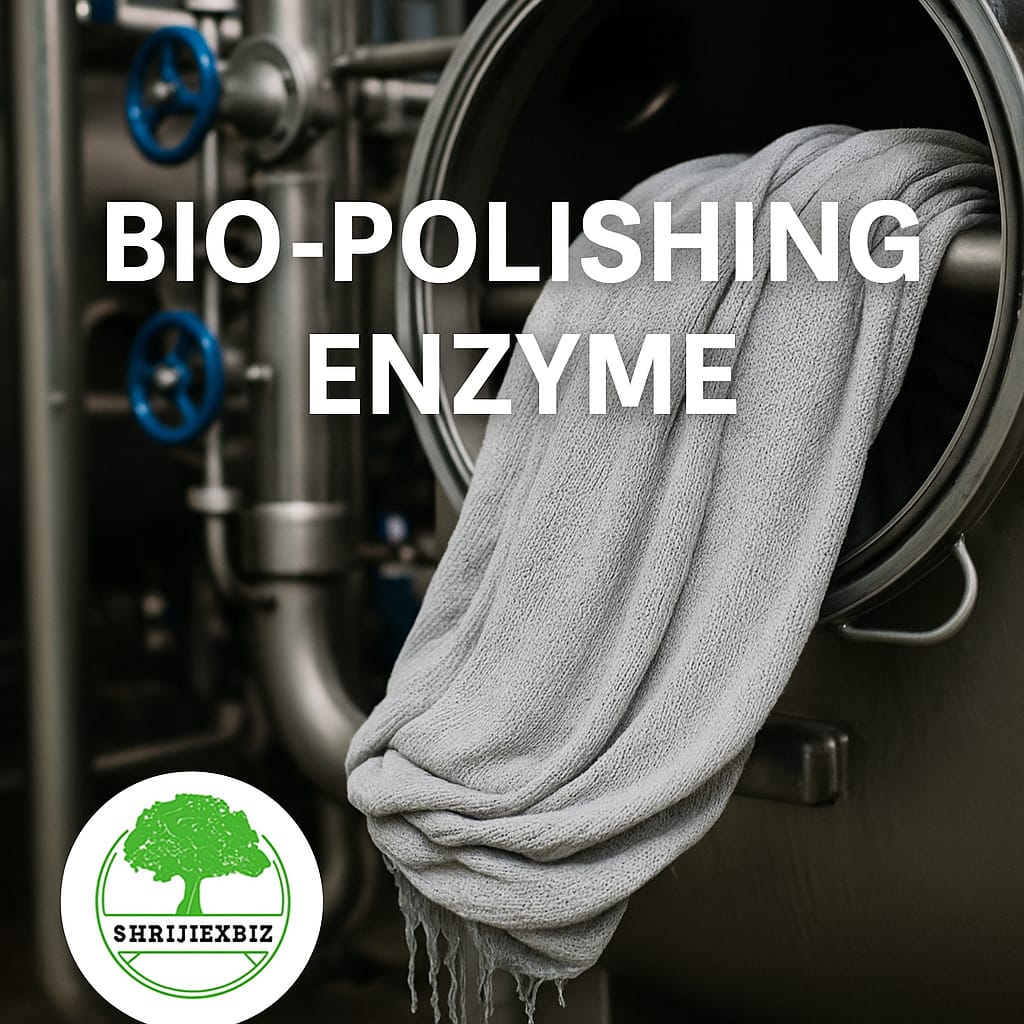
DESCRIPTION
Bio-polishing is a finishing process that enhances the fabric’s appearance and feel by removing protruding microfibers from the surface. Shrijiexbiz Pvt Ltd provides high-efficiency cellulase-based bio-polishing enzymes designed specifically for cotton and cotton blends. These enzymes gently act on the fabric surface, reducing fuzz and pilling while improving softness, smoothness, and color brightness. Our bio-polishing solutions are ideal for knitwear and woven fabrics, helping manufacturers deliver premium-quality textiles with a refined finish. With Shrijiexbiz enzymes, customers benefit from improved product aesthetics and longer fabric life in a cost-effective and sustainable manner.
Uses of Bio Polishing Enzymes
- Textile Finishing:
- Applied to cellulose-based fabrics like cotton, viscose, and lyocell.
- Removes microfibrils from fabric surface to enhance smoothness and luster.
- Denim Finishing:
- Used to create stone-washed or worn effects on denim without damaging the fabric.
- Often used as a safer, eco-friendly alternative to pumice stones.
- Woven & Knitted Fabric Enhancement:
- Improves the appearance and feel of knitwear (e.g., t-shirts, sweaters).
- Reduces pilling and fuzz on woven fabrics like bed linens and towels.
- Pre-treatment Process:
- Can be integrated with other finishing processes such as desizing and scouring to reduce steps and water usage.
Benefits:
| Benefit | Explanation |
|---|---|
| Improved Fabric Quality | Smoother texture, better drape, and enhanced softness. |
| Pilling Prevention | Reduces surface fibers that cause pilling, improving fabric durability. |
| Color Brightness | Fabric appears brighter and cleaner due to removal of surface fuzz. |
| Sustainable & Eco-Friendly | Biodegradable, reduces water and chemical usage compared to mechanical polishing. |
| Enhanced Wear Comfort | Softer, smoother fabric is more comfortable to wear. |
| Cost-Effective | Reduces need for mechanical treatments and increases fabric lifespan. |
4. Catalase – Bleaching Enzyme
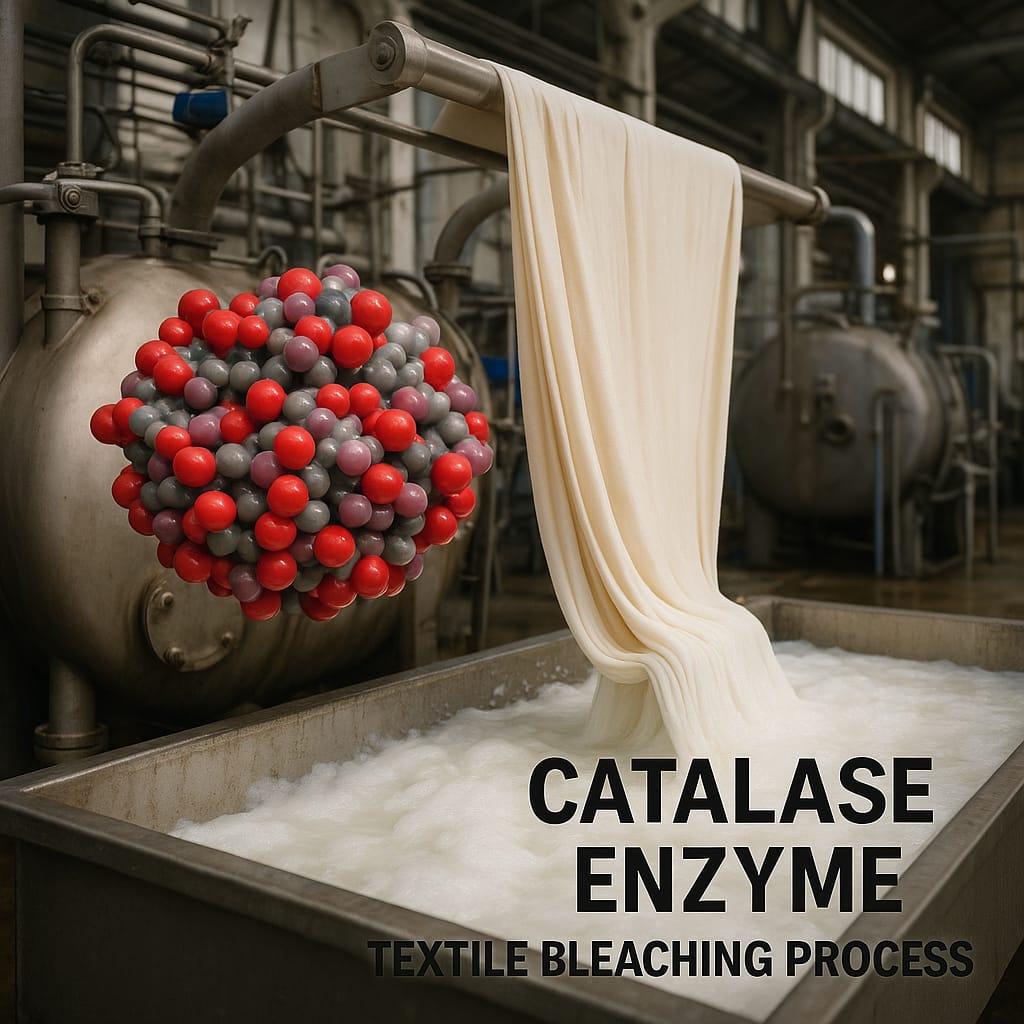
DESCRIPTION
Catalase is a powerful enzyme used predominantly in the textile industry to decompose residual hydrogen peroxide after the bleaching process. At Shrijiexbiz Pvt Ltd, we provide high-quality catalase enzymes that are specially formulated for sustainable and efficient fabric processing. After cotton bleaching, traces of hydrogen peroxide can interfere with dye uptake and fabric quality. Catalase swiftly breaks down this peroxide into harmless water and oxygen, eliminating the need for extensive water rinsing.
Uses of catalase enzyme in Bleaching process:
- Removal of Residual Hydrogen Peroxide
Catalase is primarily used to eliminate leftover hydrogen peroxide after the bleaching stage in textile processing. - Preparation for Dyeing
By removing peroxide, catalase ensures the fabric is ready for dyeing without chemical interference, improving color quality. - Eco-friendly Bleach Clean-up
Catalase replaces multiple water rinsing cycles traditionally used to wash out hydrogen peroxide, promoting sustainable processing. - Used in Cotton and Cellulose-based Fabrics
Ideal for natural fibers such as cotton, viscose, modal, and blended textiles to ensure peroxide-free, dye-ready surfaces. - Application in Continuous and Batch Processing
Suitable for both batch and continuous dyeing systems, making it versatile across various textile machinery setups. - Integration with Wet Processing Lines
Can be integrated with desizing, scouring, or bio-polishing processes, streamlining the production line.
5. Cellulase- Bio-Stoning Enzymes
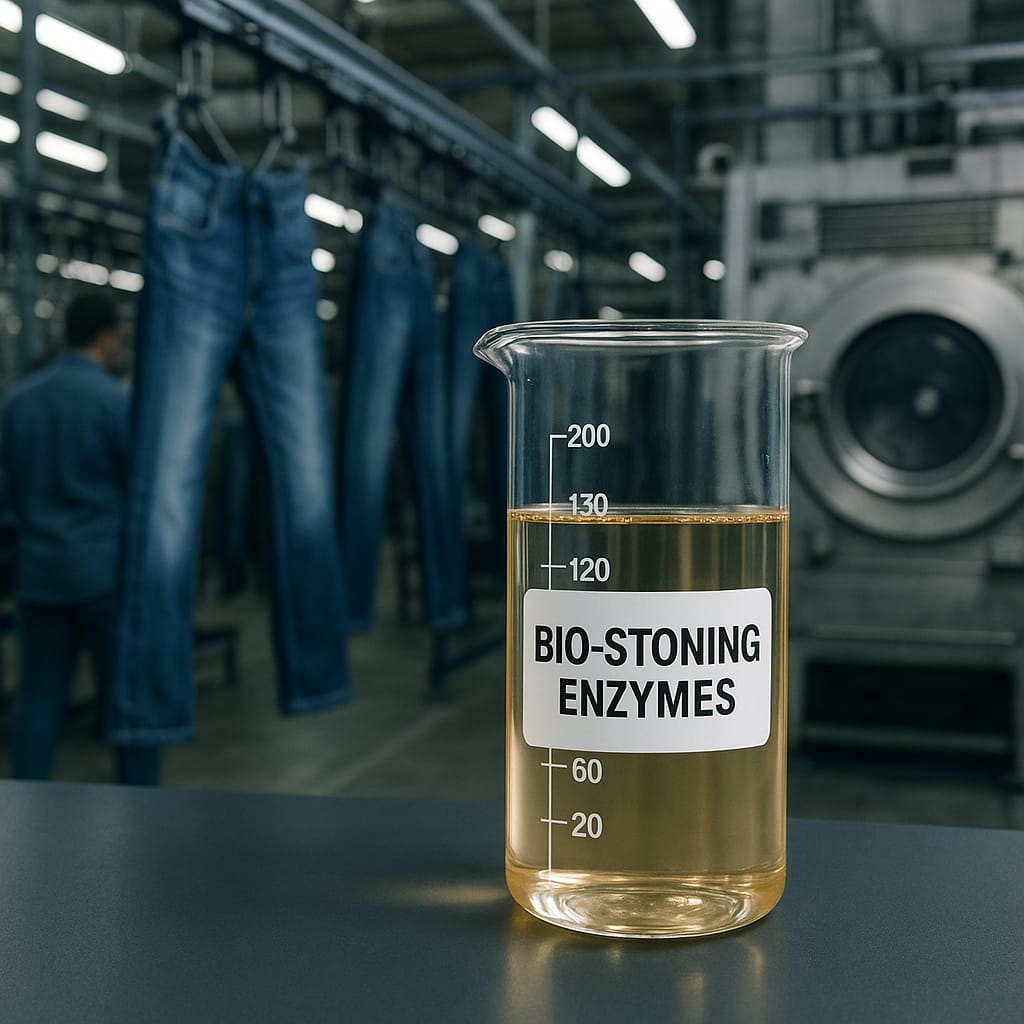
DESCRIPTION:
Bio-stoning enzymes, primarily based on cellulase technology, are used as an eco-friendly alternative to traditional stone-washing in denim and garment finishing. At Shrijiexbiz Pvt Ltd, we offer high-performance bio-stoning enzymes designed to deliver consistent results with minimal fabric damage. These enzymes work by gently breaking down the surface cellulose fibers of denim, creating a soft, worn, and faded look without the use of abrasive pumice stones.
Uses of bio-stoning enzymes
- Creating vintage, worn-out effects in denim garments
- Enhancing fabric softness and texture
- Reducing reliance on mechanical abrasion in textile processing
- Suitable for use in both batch and continuous garment washing systems
Benefits:
- Eco-friendly and sustainable, replacing stones and reducing water pollution
- Prevents fabric damage, preserving garment strength and lifespan
- Consistent and controllable results, ideal for premium denim fashion
- Lower maintenance costs, as it reduces machine wear caused by pumice stones
- Less back-staining, improving overall fabric appearance and quality
With bio-stoning enzymes from Shrijiexbiz Pvt Ltd, manufacturers can achieve high-quality denim finishes while significantly reducing their environmental footprint.
6. Protease – Wool & Silk Processing Enzyme
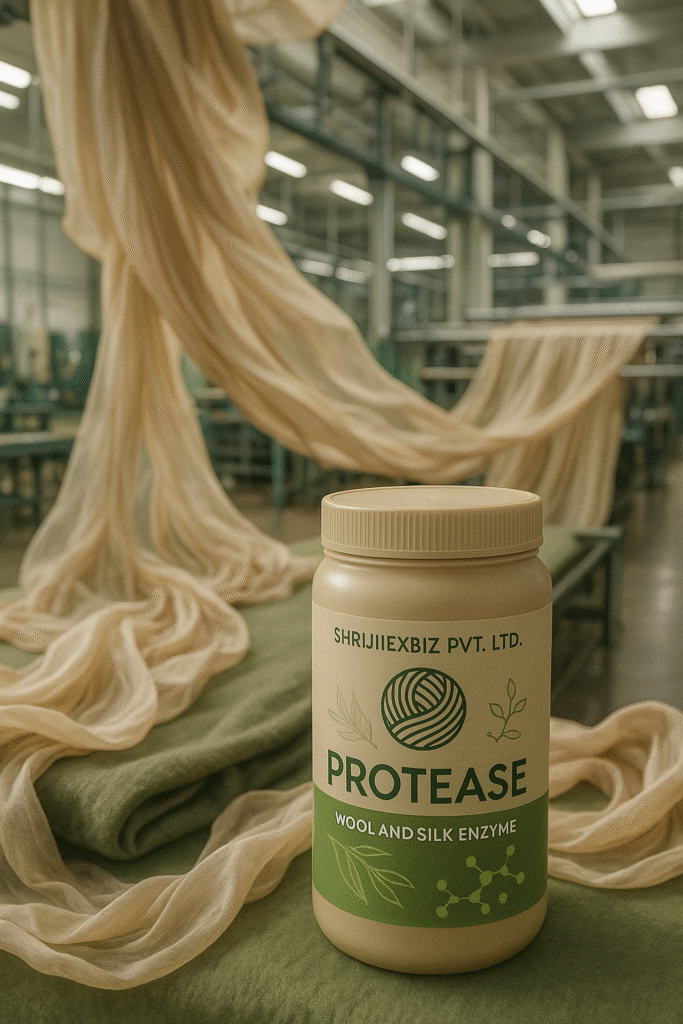
Shrijiexbiz Pvt. Ltd. offers a specialized Protease Enzyme designed specifically for wool and silk processing. This nature-based enzyme effectively breaks down and removes impurities such as sericin and other protein-based residues from delicate fabrics.
Uses:
- Scouring – Removes natural fats, oils, and dirt from wool and silk.
- Degumming – Effectively eliminates sericin from silk without damaging the fibers.
- Softening – Improves the hand feel of wool and silk, making them softer and smoother.
- Bio-polishing – Enhances the surface appearance by removing protruding fibers.
- Pre-treatment before dyeing – Increases dye absorption and ensures even coloration.
Benefits:
- Eco-friendly and biodegradable
- Gentle on delicate protein fibers
- Enhances fabric brightness and softness
- Reduces water, energy, and chemical usage
- Improves overall process efficiency
Shrijiexbiz Pvt. Ltd. ensures that its enzyme solutions support sustainable and high-quality textile processing.
conclusion
The application of enzymes in the textile industry has revolutionized traditional processes, offering eco-friendly, energy-efficient, and cost-effective solutions. Our research team has successfully developed and innovated specialized enzymes tailored for various textile processes such as desizing, bio-polishing, and bio-scouring. These advancements not only enhance fabric quality and process sustainability but also significantly reduce the industry’s environmental footprint. Our breakthrough enzyme innovation stands as a testament to our commitment to scientific excellence and sustainable textile processing, paving the way for a greener and more efficient future in the textile sector.

